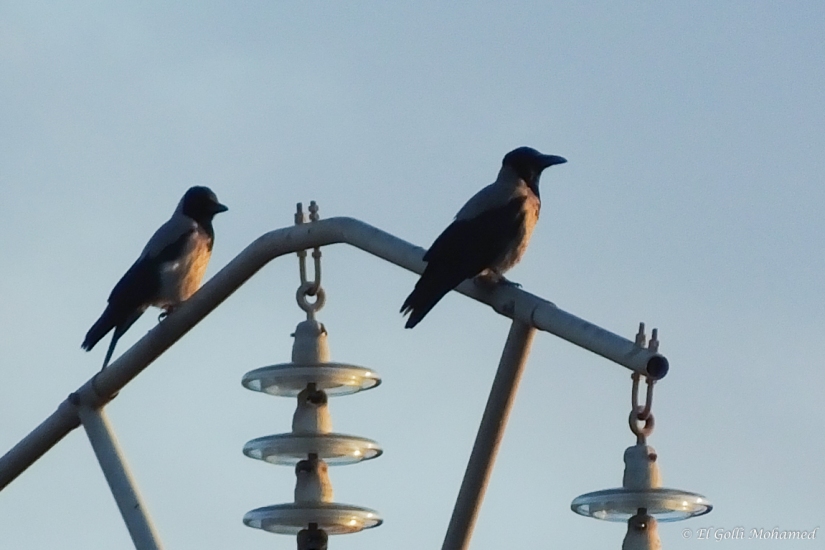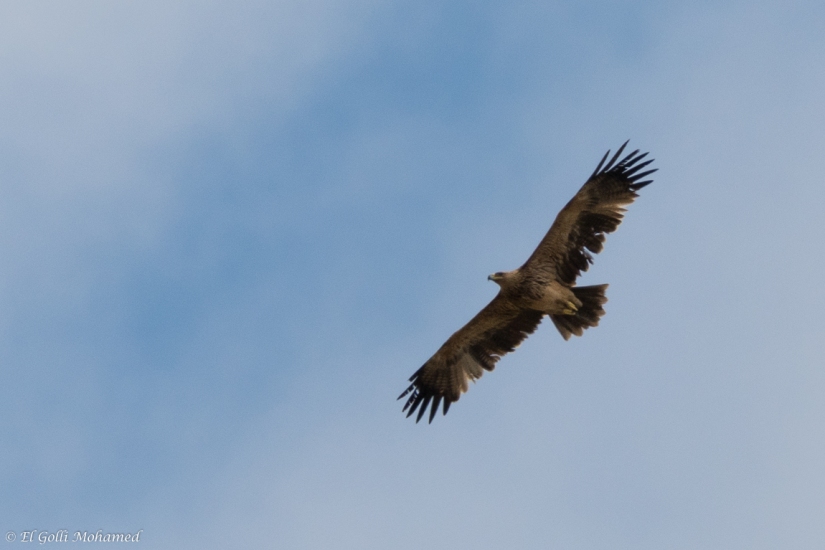First Wahlberg’s Eagle for Tunisia and 3rd for the Western Palearctic
An adult Wahlberg’s Eagle (Hieraaetus wahlbergi) photographed in spring 2018 at El Haouaria, Cap Bon, northern Tunisia (Mohamed El Golli). This is the first record for Tunisia and the third for the Western Palearctic.
Not only that, it’s the first adult and the most northern record for the Western Palearctic (WP). The first for the WP was photographed at Ras Shukeir, Gulf of Suez, Egypt in May 2013 and the second was at Cap Blanc peninsula, northern Mauritania in September 2014.
Identification
The identification was not easy though, and it’s understandable. No adult of this species has ever seen this far north. In short, there was no consensus on the ID, and a few species were suggested. When Dick Forsman was contacted, here is what he said:
“To me this is no doubt an adult Wahlberg’s Eagle, definitely not Booted Eagle, nor Lesser Spotted Eagle.
The rather narrow wings with parallel edges, the relatively long “fingers” and square wing-tip, the longish and narrow tail and the long legs (with yellow toes reaching almost to the tips of the undertake coverts) are key features in a typical Wahlberg’s Eagle silhouette. The very dark and uniform body plumage nicely fits dark individuals of this species; as do the rather plain-looking remiges and rectrices, save for a wider dark subterminal band, also typical.
A Golden Eagle would probably show golden sides to neck and the shape of the wings is too rectangular and wing-tip too square, underwing pattern also not fitting any plumage of Golden.
Silhouette/structure alone differs enough to exclude both Booted Eagle and Lesser Spotted Eagle and it is easy to find several distinctive plumage features to add.
Wahlberg’s Eagle is a highly variable species with anything from nearly white to black birds, uniformly brown being the most common. The shape is diagnostic, once familiar with the species, and the underwing remiges tend to look very uniform, lacking distinct markings. Most birds, including this, show a lighter area at the base of the outer primaries, but this may be rather indistinct.
It could well be that Wahlberg’s Eagle have been overlooked in the past as it is difficult to believe that they would suddenly have become so much more common in North Africa, with several records now pending since the first was seen in Egypt only a few years ago. Where will the next one turn up?”
El Haouaria raptor watchpoint
El Haouaria watchpoint always delivers good species. Mohamed El Golli photographed there an Eastern Imperial Eagle in spring 2017, which was the first direct observation of the species in Tunisia.
Thanks for the photographer for the excellent documentation as well as to many birders (Valéry Schollaert, Tom Conzemius, …) for the discussion. And to DF for his extensive analysis.

First record of Eastern Imperial Eagle for Tunisia and Northwest Africa
An Eastern Imperial Eagle (Aquila heliaca) was photographed in spring 2017 at El Haouaria, northern Tunisia (Mohamed El Golli). El Haouaria, located at the extreme north-east of the Cap Bon peninsula, is known as a major point for migratory raptors following the Central Mediterranean Flyway (continental Italy-Sicily-Tunisia). In our opinion, this is the first record of the Eastern Imperial Eagle for Tunisia. It’s also the first record for Northwest Africa as a whole: no previous records exist for both Algeria and Morocco.
In an article about “New bird records in Tunisia (2005-2014)”, Hichem Azafzaf and his co-authors (2015) mentioned “the observation of a radio-tracked individual born in Hungary in 2012 and photographed in November 2013 on the island of Pantelleria (east of Cape Bon)”. They added that this “suggests that the bird joined this island from Cape Bon, Tunisia”. They also added “this same individual had previously entered Africa through Libya, coming from Greece, before continuing toward Ghana (where its transmitter broke down) and returned via Burkina Faso and Niger (BirdLife Hungary, M. Prommer)”. Here is the full quote in French:
« L’observation d’un individu radio-pisté né en Hongrie en 2012 et photographié en novembre 2013 sur l’île de Pantelleria (à l’Est du Cap Bon) laisse penser que celui-ci a rejoint cette île à partir du Cap Bon en Tunisie. Ce même individu avait préalablement pénétré en Afrique par la Libye en provenance de Grèce pour se rendre ensuite au Ghana (où son émetteur est tombé en panne) et revenir par le Burkina Faso et le Niger (BirdLife Hungary, M. Prommer) ».
Based on this bird, Azafzaf et al. (2015) wrote that the Eastern Imperial Eagle could be added as a new species for Tunisie.
As you can read above, there is nothing in the text that indicates that the bird has touched or flown-over Tunisia. We would like to hear what the readers think. Are observations like this one sufficient to add a new species to the national list of the country? Thank you!
Reference:
Azafzaf, H., Feltrup-Azafzaf, C., Dlensi, H. & Isenmann, P. 2015. Nouvelles données sur l’avifaune de Tunisie (2005-2014). Alauda 83: 7-28.
Thanks to Mohamed El Golli for the photographs and information. Thanks also to Mohamed-Ali Dakhli for initiating the discussion about this eagle.
The author of the record is considering the publication of a short note detailing this observation.
Eastern Imperial Eagle / Aigle impérial (Aquila heliaca), El Haouaria, northern Tunisia, 29 April 2017 (Mohamed El Golli).
Hooded Crows at Ichkeul National Park, Tunisia
Two Hooded Crows (Corvus cornix) photographed at Ichkeul National Park, northern Tunisia on 28 December 2013 (Mohamed El Golli). Mohamed took the photo against the light, and from a distance the birds appeared dark like Common Ravens. The photo was then ignored until discovered in his archive last month.
The species is a rarity in Tunisia and only a few observations are known. ‘Birds of Tunisia’ (Isenmann et al. 2005) cites three records: two skins in a collection (collected before 1939), plus one bird in 1967 and another in 1985. In the 21st century, only one record is known: one bird at the Lake of Tunis on 9 March 2013, observed after a storm (Azafzaf et al. 2015). So the record reported here would be the fifth for the country.
Cited references are below.
Corneilles mantelées au Parc National d’Ichkeul, Tunisie
Deux Corneilles mantelées photographiées dans le Parc National d’Ichkeul, au nord de la Tunisie, le 28 décembre 2013 (Mohamed El Golli). Mohamed a récemment découvert la photo dans ses archives. Voici son message reçu le mois dernier :
La photo était prise à contre-jour durant le coucher du soleil, et de loin je pensais qu’il s’agissait d’un couple de Grand Corbeau vu que les deux individus semblaient tout noirs. En faisant le ménage ce mois-ci dans mes archives je suis tombé sur cette photo, que j’allais d’ailleurs effacer, et puis j’ai trouvé que le plumage me semblait un peu contrasté me rappelant les Corneilles mantelées que j’ai déjà vu en Turquie. J’ai donc passé la photo sur lightroom pour la traiter et l’éclaircir et bingo c’étaient deux Corneilles mantelées.
L’espèce est rare en Tunisie et seules quelques observations sont connues. ‘Oiseaux de Tunisie’ (Isenmann et al. 2005) cite trois mentions: deux exemplaires dans une collection (collectés avant 1939), un oiseau en 1967 et un autre en 1985. Au 21ème siècle, une seule observation est connue : un oiseau au lac de Tunis le 9 mars 2013, observé après une tempête (Azafzaf et al. 2015). L’observation rapportée ici serait donc la cinquième pour le pays.
Références:
Azafzaf, H., Feltrup-Azafzaf, C., Dlensi, H. & Isenmann, P. 2015. Nouvelles données sur l’avifaune de Tunisie (2005-2014). Alauda 83: 7-28.
Isenmann, P., Gaultier, T., El Hili, A., Azafzaf, H., Dlensi, H. & Smart, M. 2005. Oiseaux De Tunisie / Birds Of Tunisia. SEOF, Paris.
Merci Mohamed El Golli pour le partage de la photo et les information.

